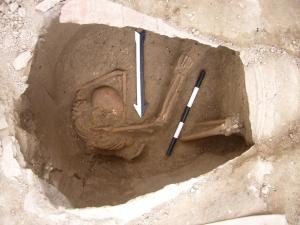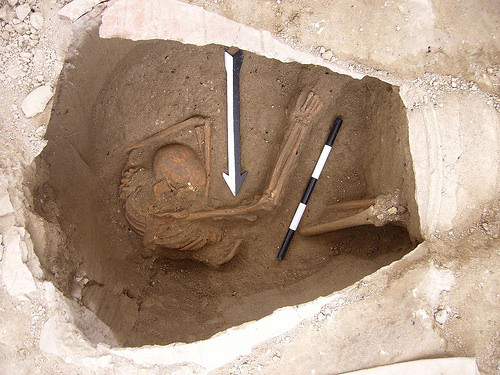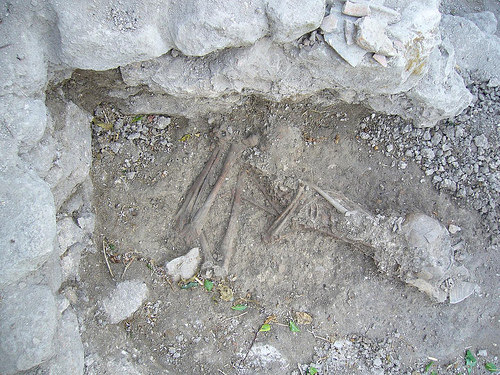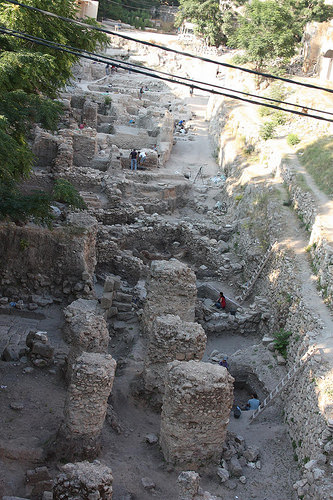
Cell Press and Wellcome Trust Sanger Institute—Thousands of years ago, the Canaanite people lived in a part of the world we now recognize as Israel, Palestine, Lebanon, Syria, and Jordan, establishing a culture that became influential in the Middle East and beyond. The Canaanites created the first alphabet, established colonies throughout the Mediterranean, and were mentioned many times in the Bible.
However, historical records of the Canaanites are limited. They were mentioned in ancient Greek and Egyptian texts, and the Bible which reports widespread destruction of Canaanite settlements and annihilation of the communities. Experts have long debated who the Canaanites were genetically. Who were they and what ultimately happened to them?
Now, researchers who’ve sequenced the first ancient Canaanite genomes along with genomes representing people from modern-day Lebanon have new information to help answer those questions. DNA evidence reported in the American Journal of Human Genetics on July 27* shows that the Canaanites did not just disappear. Instead, they survived and are the ancestors of the people now living in modern-day Lebanon.
“We found that the Canaanites were a mixture of local people who settled in farming villages during the Neolithic period and eastern migrants who arrived in the region about 5,000 years ago,” said Marc Haber (@MarcHaber) of The Wellcome Trust Sanger Institute in the United Kingdom. “The present-day Lebanese are likely to be direct descendants of the Canaanites, but they have in addition a small proportion of Eurasian ancestry that may have arrived via conquests by distant populations such as the Assyrians, Persians, or Macedonians.”
Marc Haber, Chris Tyler-Smith, and colleagues came to that conclusion after sequencing the complete genomes of five Canaanite individuals who lived almost 4,000 years ago in what’s now the modern-day Lebanese city of Sidon. They also sequenced the genomes of 99 present-day Lebanese. Those sequences enabled the researchers to analyze the Canaanites’ ancestry and assess their relationship to the people living in Lebanon today. Dr Marc Haber, first author from the Wellcome Trust Sanger Institute, said: “It was a pleasant surprise to be able to extract and analyse DNA from 4,000-year-old human remains found in a hot environment, which is not known for preserving DNA well. We overcame this challenge by taking samples from the petrous bone in the skull, which is a very tough bone with a high density of ancient DNA. This method of extraction combined with the lowering costs of whole genome sequencing made this study possible.”
The researchers estimate that new Eurasian people mixed with the Canaanite population about 3,800 to 2,200 years ago at a time when there were many conquests of the region from outside. Despite all that moving around, the Lebanese derive most of their ancestry from a Canaanite-related population, they report, suggesting that there’s been substantial genetic continuity in the region since at least the Bronze Age–a conclusion that agrees with the archaeological record.
“In light of the enormously complex history of this region in the last few millennia, it was quite surprising that over 90 percent of the genetic ancestry of present-day Lebanese was derived from the Canaanites,” Tyler-Smith said.
The findings highlight the utility of genetic studies for elucidating the history of people like the Canaanites, who left few written records themselves. The researchers say they would now like to understand the earlier and later genetic history of Lebanon and how it relates to the surrounding regions.
___________________________________
A large jar burial containing the remains of one of the individuals sequenced in the study. Credit: Dr. Claude Doumet-Serhal – The Sidon excavation
______________________________________________
The burial of a single sub adult individual sequenced in the study. Credit: Dr. Claude Doumet-Serhal – The Sidon excavation
__________________________________
The Sidon excavation site which included the burials of the studied individuals. Credit: Dr. Claude Doumet-Serhal – The Sidon excavation
_______________________________________________
Artice Sources: Adapted from Cell Press and Wellcome Trust Sanger Institute news releases.
_______________________________________________
The researchers were supported by The Wellcome Trust.
*American Journal of Human Genetics, Haber et al.: “Continuity and Admixture in the Last Five Millennia of Levantine History from Ancient Canaanite and Present-Day Lebanese Genome Sequences” http://www.cell.com/ajhg/fulltext/S0002-9297(17)30276-8
_______________________________________________
Receive 30 days free access to the popular new CuriosityStream lineup of documentaries on science, history, nature, and technology as a new Popular Archaeology premium subscriber.
___________________________________________
Travel and learn with Far Horizons.
____________________________________________
This richly illustrated issue includes the following stories: Recent findings shedding new light on the whereabouts of the remains of Philip of Macedon, father of Alexander the Great; how an archaeologist-sculptor is bringing bones of the dead back to life; archaeologists uncovering town life at the dawn of civilization; an exclusive interview with internationally acclaimed archaeologist James M. Adovasio about what makes the Meadowcroft Rockshelter prominent in the ongoing search for the first Americans; what archaeologists are finding at the site of the ancient city of Gath, the home town of the biblical Philistine giant, Goliath; and how scientists are redrawing the picture of human evolution in Europe. Find it on Amazon.com.










